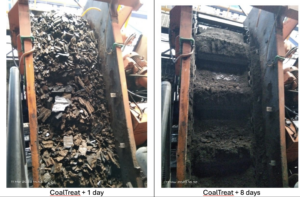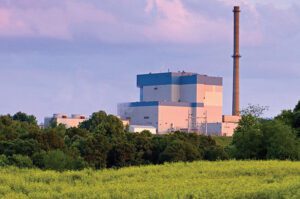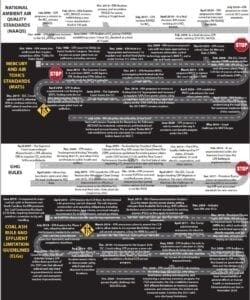coal ash
-
Coal
Coal’s Revival: From Maintenance Mode to Market Necessity
For more than a decade, the U.S. coal industry has been in decline — with waning investment, shrinking capacity, and the steady rise of gas and renewables. Yet, in 2025, a different story is emerging. Across the country, coal units once scheduled for quiet retirement are being called back into service in ways few anticipated—driven […]
-
Legal & Regulatory
EPA Extends Coal Ash Compliance Deadlines, Citing Utility, Contractor Strain
Citing a mounting compliance crunch in America’s coal-fired power sector, the U.S. Environmental Protection Agency (EPA) has finalized new rules extending key deadlines for coal ash cleanup and management, while floating the prospect of a further 12-month delay. The changes address calls from utilities, engineering contractors, and state regulators for more realistic timeframes to assess, […]
-
Coal
Reclaimed Ash: Turning Domestic, Legacy Materials into Modern Infrastructure Solutions
As government policies around energy transition continue to evolve, the pace of coal plant retirements in North America has shifted in some regions, slowing in a few cases due to energy reliability concerns. But broadly speaking, many coal-fired units have already retired, leaving behind a significant legacy challenge: the long-term management of coal ash stored […]
-
POWER Podcasts
Kingston Coal Ash Spill: Cleanup Workers Were the Unfortunate Losers
On Dec. 22, 2008, a major dike failure occurred on the north slopes of the ash pond at the Tennessee Valley Authority’s (TVA’s) Kingston Fossil Plant. The failure resulted in the release of approximately 5.4 million cubic yards of coal ash spilling onto adjacent land and into the Emory River. The Kingston spill is considered […]
-
Commentary
Federal Court Blocks Attempt by Coal Power Plants to Evade Cleaning Up Coal Ash Sites
The U.S. Court of Appeals in Washington, D.C., on June 28 blocked the coal power industry’s attempt to get out of the requirement that they prevent toxic coal ash from contaminating groundwater. The court affirmed that the EPA regulations established in 2015 already prohibit closing coal ash dumps with ash sitting in groundwater. Industry filed […]
-
Legal & Regulatory
EPA Unleashes Four-Pronged Assault on Fossil Fuel Power Pollution
In an unprecedented move, the U.S. Environmental Protection Agency (EPA) on April 25 simultaneously finalized four major environmental rules covering greenhouse gases (GHG), air toxics, wastewater discharges, and coal combustion residuals from fossil fuel-fired power plants. Among the rules is the EPA’s final Carbon Pollution Standards, which marks the agency’s third attempt to broadly curb […]
-
Commentary
The Cobra Effect of Fly Ash from Coal Power Plants in India
Have you heard about the cobra effect? During the colonial era, Delhi had a major cobra issue. The then-British government announced a bounty for dead cobras to reduce the number of snakes on the streets. Entrepreneurial spirits rose as people started breeding cobras and offered a dead one on the bounty. Money given on bounty […]
-
Legal & Regulatory
EPA’s Expansion of Coal Ash Regulation Could Impact Beneficial Use
The U.S. Environmental Protection Agency (EPA) in May of this year issued a proposed rule that would greatly expand the scope of federal regulations governing the management of coal combustion residuals, or
-
Legal & Regulatory
EPA Moves to Deny Coal Ash Disposal at Six Massive Coal Power Plants
The U.S. Environmental Protection Agency has proposed barring six coal-fired power plants in various states—a combined 11 GW—from disposing coal ash into unlined surface impoundments. The agency, however, also proposed to provide disposal extensions if the coal plants are needed to maintain grid reliability. The EPA’s proposed determinations, issued on Jan. 25, fall under its […]
-
Legal & Regulatory
Biden Administration Rolls Out ‘Durable’ WOTUS Definition in Final Rule
The Biden administration has rolled out in a final what it says is a “durable” definition of “waters of the U.S.” (WOTUS), potentially capping a legal and political battle that has raged for nearly two decades. The final rule issued by the U.S. Environmental Protection Agency (EPA) and the U.S. Department of the Army on […]
-
O&M
Water Quality Management and Control—Managing the Second-Largest Waste Material in the U.S.
Coal ash, or coal combustion residuals (CCRs), is the second-largest waste material in the U.S., just behind household garbage. The safe and sustainable management of coal ash poses one of the most complex
-
Coal
TVA Will Explore Building Utility-Scale Solar on Closed Coal Ash Sites
The Tennessee Valley Authority (TVA) will pursue a first-of-its-kind pilot program at the Shawnee Fossil Plant in West Paducah, Kentucky, to determine if closed coal ash sites are suitable for utility-scale solar projects. The self-funded U.S. corporate agency’s board on Nov. 10 unanimously approved a $216 million pilot project to explore repurposing the 1,071-MW coal-fired power […]
-
Press Releases
Charah Solutions Awarded 9-Year Multi-Pond Ash Pond Excavation Contract from Long-Term Southeastern Utility Partner
Award Represents One of the Largest and Longest Term Projects in Company History Includes Excavation of Approximately 4.3 Million Cubic Yards of Coal Combustion Residuals from Three Ash Ponds to Support Ongoing Beneficiation Activities and Facilitate Future Pond Closures LOUISVILLE, KY (July 28, 2022) – Charah® Solutions, Inc. (NYSE: CHRA) (“Charah Solutions” or the “Company”), […]
-
Coal
Plant Bowen Will Showcase Largest Coal Ash Beneficial Use Project in the U.S.
Georgia Power will harvest 9 million tons of coal ash landfilled at its 3.4-GW Plant Bowen station in Bartow County, Georgia, and beneficially use it in concrete for major regional construction projects. The project, announced on June 29, will be the “ single largest beneficial use project of its kind in the U.S., and the largest […]
-
Coal
The Convoluted Tale of U.S. Coal Ash Management
Sometime around midnight on Dec. 22, 2008, a dike at the coal ash dewatering pond for the Tennessee Valley Authority’s (TVA’s) 1,400-MW Kingston power plant in Roane County, Tennessee, failed. That led to what has been reported as the largest industrial spill in U.S. history. TVA and the U.S. Environmental Protection Agency (EPA) initially estimated […]
-
Press Releases
Charah Solutions Awarded 5-Year Fly Ash, Bottom Ash and Boiler Slag Sales and Marketing Contract From Associated Electric Cooperative to Run Through 2026
Approximately 150,000 Tons of Byproducts Per Year Will be Recycled and Sold for Beneficial Use into the Ready-Mix Concrete and Aggregate Industries LOUISVILLE, KY (November 4, 2021) – Charah® Solutions, Inc. (NYSE: CHRA) (the “Company”), a leading provider of mission-critical environmental services and byproduct sales to the power generation industry, today announced that it has […]
-
Press Releases
Charah Solutions Awarded Multiple Contracts by Long-Term Southeastern Utility Partner for Construction and Ash Pond Closure Projects
Scope of Projects Includes Site Clearing, Road Construction, Ash Stabilization, Ash Excavation and Ash Relocation LOUISVILLE, KY (October 21, 2021) – Charah® Solutions, Inc. (NYSE: CHRA) (the “Company”), a leading provider of mission-critical environmental services and byproduct sales to the power generation industry, today announced that it has been awarded two ash pond closure contracts […]
-
Coal
Addressing the Increased Need to Decommission Power Plants in a Sustainable Manner
Coal-fired power plant decommissioning and remediation work is not typically a utility company’s core business. That’s why having the right partner and implementing a sound plan to ensure both
-
Coal
The Remarkable Responsibility of Coal Refuse Power
West Virginia’s only remaining coal refuse–fueled facility, the 80-MW Grant Town Power Project, is a 2021 Top Plant winner for powering on, despite challenges, to remediate 530,000 tons of coal refuse annually while reclaiming roughly 30 acres of land per year.
-
Press Releases
United Conveyor Corporation Acquires North American Bottom Ash Material Handling Offerings from GE Steam Power
Waukegan, IL – May 3, 2021 – United Conveyor Corporation (UCC) announced today that the company has acquired GE Steam Power’s bottom ash business in North America. The deal reached April 21 includes intellectual property, know-how, and inventory transfer. This agreement combines the strengths of UCC and GE Steam Power’s bottom ash capabilities and will […]
-
O&M
Custom Lift Safely Elevates Coal Ash Conveyor in Tight Space
A Midwestern power plant faced a logistical challenge when it came time to replace its coal ash conveyor. The new conveyor was 110 feet long and weighed a hefty 138 tons—and it needed to be lifted 10 feet
-
Coal
Duke Energy Reaches $1.1B Deal to Resolve North Carolina Coal Ash Cost Issues
In a milestone settlement that could resolve Duke Energy’s “last remaining major issues” on coal ash management in North Carolina, the utility has agreed to absorb $1.1 billion in cleanup costs anticipated between 2015 and 2030. The proposed settlement, which Duke Energy filed with the North Carolina Utilities Commission (NCUC) on Jan. 25, is a […]
-
Coal
THE BIG PICTURE: EPA Regulatory Roundup
Over its 50-year history, several rules issued by the U.S. Environmental Protection Agency (EPA) have reshaped the power sector. But for at least a few modern rules, the road has been full of turns. Notes: CAA = Clean Air Act; BSER = best system of emission reduction; CO2 = carbon dioxide; GHG = greenhouse gases; […]
-
Coal
AEP Will Shutter Nearly Half its Giant Coal Power Fleet—5.6 GW—by 2030
American Electric Power (AEP) will shut down or refuel 5.6 GW of its 2020 coal-fired power fleet by 2030 to comply with environmental rules—including recent revisions governing federal coal ash and effluent limitations—and rebalance its portfolio in a bid to meet ambitious climate goals. The move is bold for the Columbus, Ohio-based generating giant, which […]
-
Coal
Khargone: India’s High Efficiency Leap
Indian power giant NTPC commissioned the second unit of the vast 1,320-MW Khargone Super Thermal Power Project in Madhya Pradesh this March, completing its first ultrasupercritical power plant. The project’s
-
Coal
EPA Changes Closure Requirements in Coal Ash Rule
The U.S. Environmental Protection Agency (EPA) on July 29 finalized several changes to the regulations for disposal of coal combustion residuals (CCRs), or coal ash, from electric utilities. The changes include giving utilities more time to design clean-up and closure plans for their coal ash storage sites. The changes stem from an opinion issued Aug. […]
-
Coal
Charah Solutions Awarded Large-Scale Pond Closure Contract by Southeastern Utility for Beneficial Use
Over 2 Million Tons of Ash from Retired Coal-Fired Power Plant Will Be Beneficially Used in Concrete Industry LOUISVILLE, KY (April 28, 2020) – Charah® Solutions, Inc. (NYSE: CHRA) (the “Company”), a leading provider of environmental and maintenance services to the power generation industry, today announced that it recently was awarded a Closure by Removal […]
-
News
At Least Two Dead in Coal Ash Breach in India
A dike at a coal ash pond at a power plant in India gave way on April 10, killing at least two people while four others are missing, according to a local official. The spill covered several acres of cropland in the area. K.V.S. Choudary, the district collector and the top public official in the […]
-
Press Releases
Georgia Power issues Request for Proposals for beneficial-reuse of stored coal ash from closed ash ponds
Company already recycles more than 75 percent of currently-produced ash NEWS PROVIDED BY Georgia Power Jan 08, 2020, 12:21 ET ATLANTA, Jan. 8, 2020 /PRNewswire/ — Georgia Power today announced it is requesting proposals for the beneficial reuse of coal ash stored at active and retired coal-fired power plants across the state. While Georgia Power […]
-
News
Settlement Reached in Largest U.S. Coal Ash Cleanup
Duke Energy will save about $1.5 billion in coal ash cleanup costs under a settlement between the utility and environmental and other groups announced Jan. 2 by North Carolina’s Department of Environmental Quality (DEQ). The DEQ said Duke Energy will need to excavate about 80 million tons of coal ash currently stored in basins at […]
























